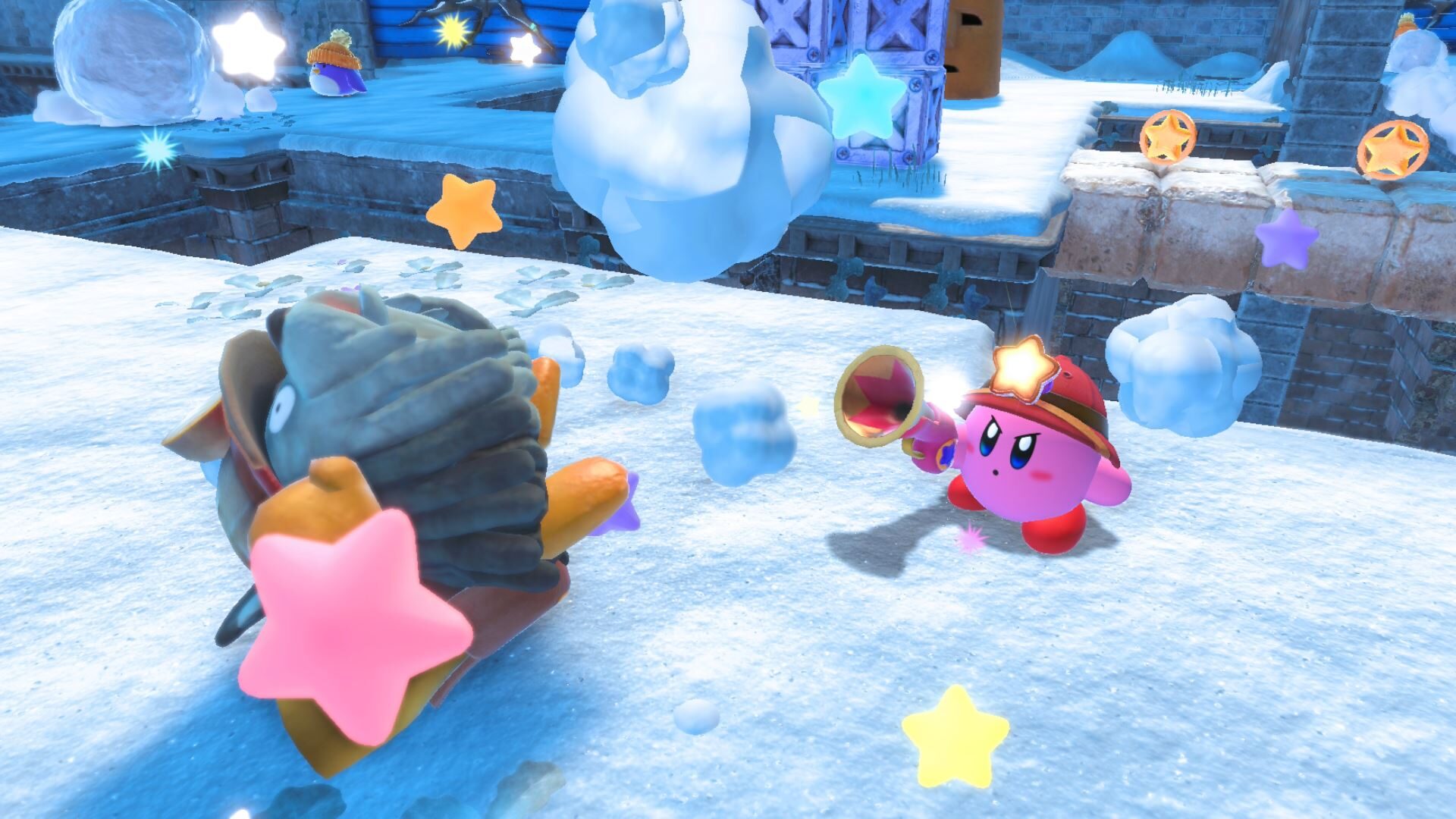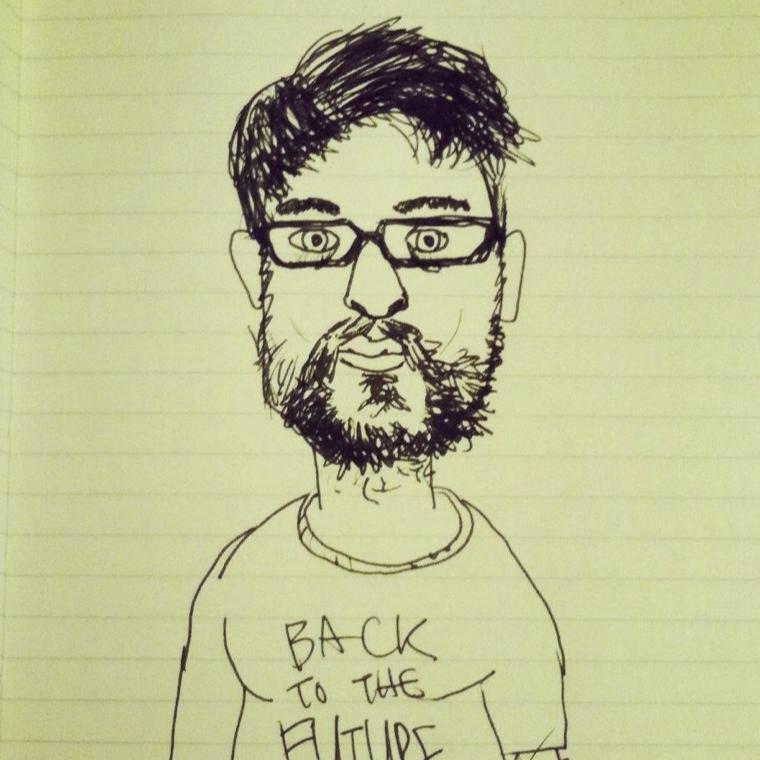Mario and Zelda both made the move to 3D over two decades ago, but it took until the Switch era for Kirby to add the Z axis to his dimensions of movement. It’s easy to imagine what challenges a designer might face in translating Kirby to a 3D space. Compared to Mario, Kirby’s movement is limited to running and floating. And compared to Link, who can call upon any number of gadgets at any given time, Kirby can only use the special move of whatever enemy he’s most recently hoovered up.
It might have taken nearly 30 years, but HAL Laboratory finally seems to have cracked the code with Kirby and the Forgotten Land. Given the character’s limitations, the longtime Kirby developer made the smart decision and gave the character more focused 3D levels, while extending the character’s abilities with the new Mouthful Mode just enough to keep things interesting.
Opening with another overly dramatic, Kirby-centric cutscene, Forgotten Land finds Planet Popstar under attack by a mysterious, intergalactic force that’s kidnapping Waddle Dees. Swept up in the action, Kirby becomes stranded in what appears to be a new, post-apocalyptic world and sets out to rescue the Waddle Dees with the help of a new ally named Elfilin. Other than the intro and the opening credits, we don’t get any other story beats until the last level, which is completely back-loaded with context about the world and the antagonists’ motivations. It seems silly to wish there were additional story moments in a Kirby game, but HAL’s cutscenes are so good that they left me wanting more.

Of course, it’s a Nintendo game, and a Kirby game specifically, so the story is kind of besides the point. What really matters is how HAL translated Kirby’s traditional suck-centric gameplay into a space with three dimensions instead of two, and that’s something that Forgotten Land does quite successfully.
Instead of giving Kirby a wide open area to explore, Forgotten Land takes a more linear approach to its design. Similar to how Super Mario 3D World or the Galaxy games keep the red-hatted plumber on a relatively straight and narrow path, Forgotten Land makes sure that Kirby is always moving in the right direction and not floating off every which way or having to cover too much extra ground with his slow and squishy movement.
Forgotten Land’s levels feel both straightforward and complex, thanks to some clever puzzles, a ton of hidden areas, and secret side objectives that players must discover for themselves. Sometimes these side objectives are as simple as picking up all the hidden coffee cups, while others require you to get through certain parts of a level without taking a hit. While Forgotten Land’s levels rarely feel significantly challenging, discovering the secret objectives and hidden areas with additional Waddle Dees to rescue can feel rewarding and add some replayability.
Besides translating Kirby into a 3D space, Forgotten Land’s other biggest contribution to the series is its new Mouthful Mode. One can almost imagine the developers having that eureka moment: What if Kirby didn’t just suck up enemies but an entire car? Each level has at least one major Mouthful Mode set piece where Kirby has to take on the property of an inanimate object to navigate a puzzle, and the best Mouthful Modes—like the car or the glider—show up just often enough to stay exciting without becoming rote. While it doesn’t feel as inventive or as integral to Forgotten Land as Mario’s transformations did in Super Mario Odyssey, Mouthful Mode does enough to mix up the standard Kirby gameplay while giving level designers more room to create interesting puzzles and isolated gameplay moments.

Forgotten Land also introduces a handful of new copy abilities that players can use throughout the levels any time they want, thanks to the weapon shop in the game’s hub world. The Drill and Ranger abilities slot in nicely with the more traditional copy abilities like the Sword, the Bomb, and the Cutter, to name a few. Forgotten Land takes these abilities a step further and lets players upgrade them at the weapon shop, so that when you pick up, say, the Sword in a level, you will get whatever version of the sword you previously selected at the shop. Most of them, like the Sword and the Bomb, have signfiicantly better versions, though other abilities’ upgrades seem less impactful.
Upgrading Kirby’s copy abilities requires star coins and rare stones, the latter of which you’ll earn by completing different Treasure Hunts. These timed challenges each focus on a specific ability (or its upgraded version) or Mouthful Mode, and provide some of the most challenging gameplay in Forgotten Land. Treasure Hunts, as well as other side activities that can be found in the game’s hub world and the post-credits bonus levels, provide enough distraction and challenge to give players more to do in addition to going through the rest of Forgotten Land’s relatively short but sweet story. Add co-op to that, and you have yet another reason to replay levels you might have already completed.
Kirby levels do lose something in their translation to 3D, however, and that’s verticality. The majority of Kirby’s adventures in the Forgotten Land feel surprisingly flat in a way that seems both counter to the identity of the series and a waste of the space granted to it from its new perspective. Kirby was never the most traditional platformer, but the pink puffball’s ability to float always seemed to factor in much more than it does in Forgotten Land. Except in boss fights, floating even feels like a liability at times, especially since Kirby moves so slowly when floating and it’s so easy to trigger. That being said, the aforementioned boss fights in Forgotten Lands are the best that the series has ever seen—especially the final boss, which feels appropriately challenging and climactic.
For its first 3D adventure, Kirby and the Forgotten Land does a great job translating the series’ traditional 2D gameplay into a new dimension. While it definitely could have used more of pretty much everything, HAL has laid a good foundation for what a 3D Kirby game looks (and plays) like. It doesn’t stand out as much as other first-party Switch titles, but it’s a solid enough offering that shows Kirby is a mascot worthy of a top-tier 3D adventure.

Images: Nintendo
|
★★★★☆
Kirby and the Forgotten Land does pretty much everything it needs to as the pink puffball’s first 3D adventure. Clever level design and the appropriately named Mouthful Mode show that Kirby’s floating, sucking ways can work in a 3D space. Forgotten Land might not reach the highest heights of Nintendo’s other first-party adventures, but it definitely shows that Kirby can hold his own in a three-dimensional arena. |
Developer HAL Laboratory Publisher Nintendo ESRB E - Everyone Release Date 03.25.22 |
| Kirby and the Forgotten Land is available on Nintendo Switch. Primary version played was for Switch. Product was provided by Nintendo for the benefit of this coverage. EGM reviews on a scale of one to five stars. | |

Michael Goroff has written and edited for EGM since 2017. You can follow him on Twitter @gogogoroff.